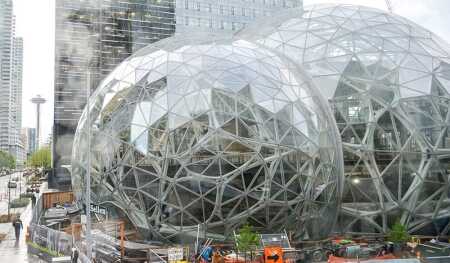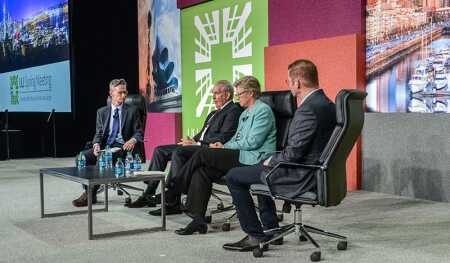
The tallest of the glass-and-metal Spheres at Amazon’s Doppler Building in Seattle rises 90 feet (27 m) and is more than 130 feet (40 m) in diameter, with two smaller spheres to each side. In a city that gets 152 days of rain a year, they will provide a warm, dry, plant-filled space for meetings, meals, and mingling for up to 800 Amazon employees at a time.
The creation of Amazon’s headquarters in downtown Seattle is a story of repeated failures, patience, and more than a few twists of fate.
Three of the primary participants in the project came together during the 2017 ULI Spring Meeting for a discussion of the long history that led to the development of the internet retailer’s campus, which has been called “the largest corporate headquarters in urban America.” At the end of 2016, Amazon occupied 34 buildings and more than 8.5 million square feet (790,000 sq m) on the north side of the city, with more in the pipeline.
“It is fair to say in no time in our history has there been such an intense building boom that has been both precipitated and directed” by one company, said moderator Leonard Garfield, executive director of the Seattle Museum of History and Industry.
Most of the development has come together since 2010, as the fast-growing company confronted its need for more space and a desire to keep the company together in downtown Seattle.
“We wanted it to be a true urban infill project,” said John Schoettler, vice president of global real estate and facilities for Amazon. “We didn’t want it to look like a suburban campus.”
The ability of Amazon to find such a large amount of developable property in the urban core—at exactly the time it needed millions of square feet of office space—was alone a stroke of luck, said Alfred Clise, chairman and chief executive officer of Clise Properties.
“Few if any cities could offer such a large, continuous collection of unencumbered, undeveloped land in a dense urban core, zoned for high-rise construction, owned by single company,” Clise said.

From left to right: Leonard Garfield, executive director of Seattle’s Museum of History & Industry; Alfred Clise, chairman and CEO of Clise Properties; Ada Healey, vice president of Vulcan; and John Schoettler, vice president, global real estate and facilities, for Amazon, speaking at the 2017 ULI Spring Meeting in Seattle.
The creation of the Amazon campus involves two very different long-term development stories, panelists said. One was the progress of the area known as the Denny Triangle, where family-owned Clise Properties had been buying and holding land for generations.
During the mid-2000s, Clise Properties was marketing a 13-acre (5.3 ha) parcel in the Denny Triangle, which attracted interested from around the world. “We didn’t want to sell off pieces,” Clise said. That would “obliterate the [family company’s] vision” for the area, he said.
In 2008, Clise Properties was close to completing an agreement to develop the site with Dubai-based Emaar Properties, builder of Burj Khalifa, the tallest building in the world. The deal collapsed, however, when the global real estate market fell into recession.
“Once again, we had to practice the art of patience,” Clise said.
The property was still available in 2010, when Amazon was looking to expand. At first, the companies tried to negotiate a lease for the site, which “didn’t go well,” Clise said. Eventually, Amazon bought 4.5 continuous acres (1.8 ha), where it has built two towers, with three more in development.
Amazon also connected to a neighboring Clise data center to create a unique waste heat–sharing system. Heat from the data center is pumped down the building to a series of heat exchangers, which is sent to the Amazon building, where it is used for heat and chilled water, which is sent back to the Clise building.
“It’s a simple loop system,” Clise said, adding, “It’s never been done in this country.”
The second part of the equation was the twisted road that led to the redevelopment of South Lake Union, which was known as a neighborhood of parking lots, low-grade industrial uses, and strip joints. “It was a neighborhood you drove through, you did not drive to,” said Ada Healey, vice president of the real estate arm of Vulcan Inc., Microsoft cofounder Paul Allen’s company.
During the 1990s, Allen became involved in a plan to turn the area into a grand urban park, in the style of New York City’s Central Park. He put in $30 million of seed money to buy land for the project, dubbed Seattle Commons. But voters twice rejected the plan, which turned Allen toward redeveloping the area, Healey said.
With a light-rail link in place and redevelopment picking up steam, South Lake Union was in an ideal situation when Amazon was looking to expand.
“One of the key reasons that transaction was able to come about was that we controlled a lot of land and we were one owner,” Healey said. “And we could deliver a lot of square footage in a short amount of time.”
Vulcan delivered Amazon’s first building in 2010, with 11 more to follow through 2012, including two historic rehabilitations. Along with the projects developed on the Clise-controlled properties, Amazon’s downtown presence is expected to grow to more than 12 million square feet (1.1 million sq m), which might represent as much as 20 percent of the city’s office space.
“We want to get it right,” Schoettler said. “We want to stitch ourselves into the fabric of the community.”
The project also includes the “spheres,” three glass domes rising up to 90 feet (27 m), which are part office space and part botany experiment. The four-story “indoor forests” will include more than 10,000 plants, and 45-foot-tall (14 m) trees, Schoettler said. Amazon is growing its own plants and has employed a staff horticulturist, he said.
Amazon realized that “something missing was the link to nature,” Schoettler said.
In reviewing the project, the panelists said they repeatedly returned to the many factors that had to come together to turn Amazon’s vision into a reality. One key step was Seattle’s willingness to relax height and density restrictions, Clise said. “You need flexible zoning,” he said. Without the zoning changes made in the 1980s, “the Amazon high-rise campus of today would not exist,” he said.
The panelists were asked to share the lessons they learned from the experience. “Try to celebrate small successes,” Healey said. “And never take anything for granted.”
For Amazon, persistence and a willingness to look to the future and take risks played a big role in the process, Schoettler said.
“You’re going to make mistakes. Mistakes are O.K.,” he said. As a pioneer, you “have to be willing to make mistakes and take big, bold bets.”
Kevin Brass writes regularly about property and development for the New York Times and Financial Times





